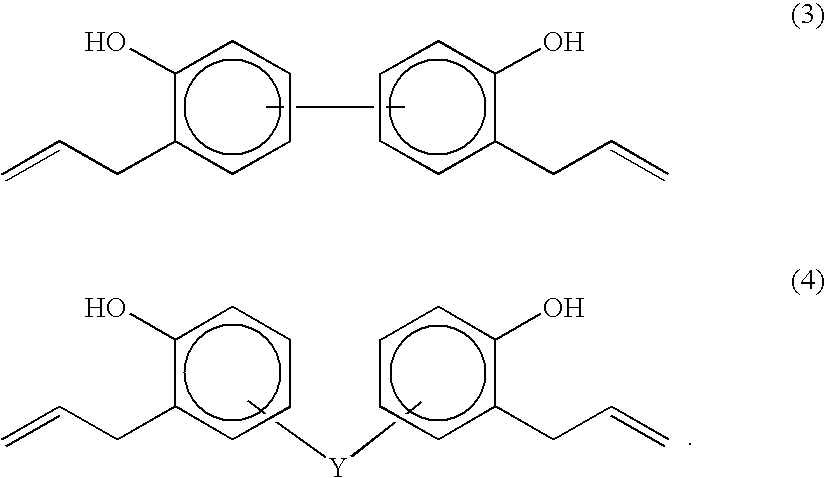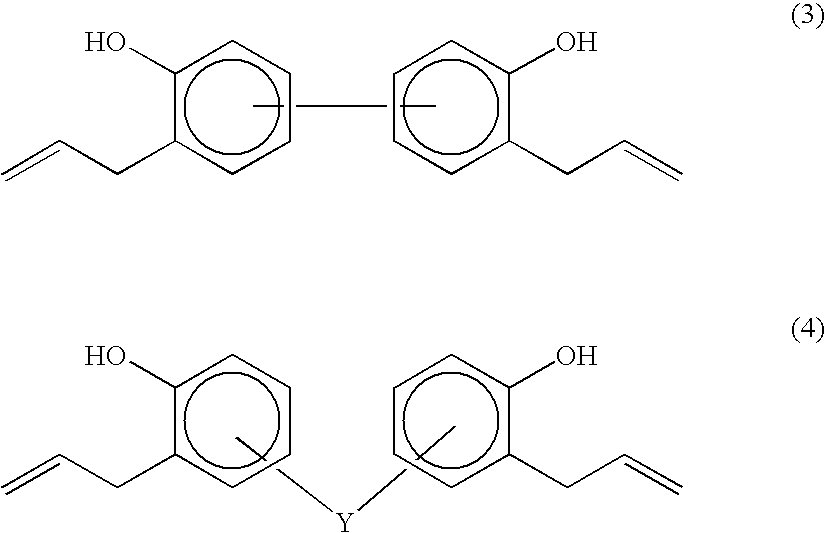Organosiloxane polymer, photo-curable resin composition, patterning process, and substrate protective film
a technology of organic siloxane and resin, applied in the direction of photosensitive materials, instruments, photomechanical equipment, etc., can solve the problems of insufficient photocurability of resin to achieve precise micro-patterning, thick films tend to lose sensitivity, easy delamination or cracking, etc., to improve substrate adhesion, improve substrate adhesion, and high dielectric strength
- Summary
- Abstract
- Description
- Claims
- Application Information
AI Technical Summary
Benefits of technology
Problems solved by technology
Method used
Image
Examples
synthesis example 1
[0160]A flask equipped with a stirrer, thermometer, nitrogen purging line and reflux condenser was charged with 48.0 g of 4,4′-(1-methylethylidene)bis[(2-propenyl)phenol], 9.6 g of 1,3,5,7-tetramethyl-1,3,5,7-tetravinylcyclosiloxane, 160 g of toluene and 0.04 g of chloroplatinic acid and heated at 80° C.
[0161]Then 22.4 g of 1,3-dihydro-1,1,3,3-tetramethyldisiloxane was added dropwise to the flask. After the dropwise addition, the reaction solution was ripened for 2 hours at 80° C. whereupon the toluene was distilled off. The series of steps yielded 77 g of a liquid product. A GPC analysis revealed a weight average molecular weight of 50,000 based on polystyrene standards.
synthesis example 2
[0162]A flask equipped with a stirrer, thermometer, nitrogen purging line and reflux condenser was charged with 19.4 g of 3,3′-diallyl-4,4′-biphenyl diol, 5.1 g of a copolymer consisting of (CH3)3SiO1 / 2 units, (CH3)2(CH2═CH)SiO1 / 2 units and SiO4 / 2 units in a molar ratio of 40:15:45 and having a weight average molecular weight of 8,000 as determined by GPC using polystyrene standards, 200 g of toluene and 0.05 g of chloroplatinic acid and heated at 80° C. Thereafter, 75.5 g of an organohydrogensiloxane of the average structural formula (10) was added dropwise to the flask.
[0163]
After the dropwise addition, the reaction solution was ripened for 2 hours at 80° C. whereupon the toluene was distilled off. The series of steps yielded 97 g of a product. A GPC analysis revealed a weight average molecular weight of 80,000 based on polystyrene standards.
synthesis example 3
[0164]A flask equipped with a stirrer, thermometer, nitrogen purging line and reflux condenser was charged with 24.4 g of 4,4′-(1-methylethylidene)bis[(2-propenyl)phenol], 1.3 g of an organosiloxane of the average structural formula (11), 200.0 g of toluene and 0.05 g of chloroplatinic acid and heated at 80° C.
[0165]
Thereafter, 74.3 g of an organohydrogensiloxane of the average structural formula (12) was added dropwise to the flask.
[0166]
After the dropwise addition, the reaction solution was ripened for 2 hours at 80° C. whereupon the toluene was distilled off. The series of steps yielded 96 g of a liquid product. A GPC analysis revealed a weight average molecular weight of 100,000 based on polystyrene standards.
PUM
| Property | Measurement | Unit |
|---|---|---|
| wavelength | aaaaa | aaaaa |
| temperature | aaaaa | aaaaa |
| temperature | aaaaa | aaaaa |
Abstract
Description
Claims
Application Information
 Login to View More
Login to View More - R&D
- Intellectual Property
- Life Sciences
- Materials
- Tech Scout
- Unparalleled Data Quality
- Higher Quality Content
- 60% Fewer Hallucinations
Browse by: Latest US Patents, China's latest patents, Technical Efficacy Thesaurus, Application Domain, Technology Topic, Popular Technical Reports.
© 2025 PatSnap. All rights reserved.Legal|Privacy policy|Modern Slavery Act Transparency Statement|Sitemap|About US| Contact US: help@patsnap.com



